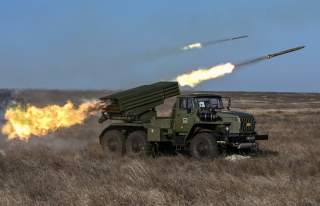 Key point: Here is what could happen if Russia and America fought. Moscow has invested a lot in its electronic warfare capabilities.
Key point: Here is what could happen if Russia and America fought. Moscow has invested a lot in its electronic warfare capabilities.
The U.S. military is spending more and more on electronic-warfare systems, all in a desperate bid to keep pace with China and Russia’s own investments in jammers.
But the roughly $10 billion that the Pentagon plans to spend on electronic warfare every year over the next five years isn’t helping as much as it should, the Center for Strategic and Budgetary Assessments explained in a November 2019 report.
This first appeared in 2019 and is being reposted due to reader interest.
“The growth in [Defense Department] E.W. spending ... is not guided by a coherent vision of how U.S. forces would operate and fight in the [electromagnetic spectrum, or EMS] and is unlikely to yield significant improvements against China and Russia, the U.S. military’s most challenging competitors,” CSBA experts Bryan Clark, Whitney McNamara and Timothy Walton explained.
The Pentagon in 2017 published a new strategy for E.W. investment, which covers a wide range of programs for scrambling enemy sensors and communications. But “new networked, cognitive and agile E.W. technologies called for in the 2017 E.W. strategy have been slow to transition into operational systems, and [research-and-development] spending to field those capabilities is projected to decrease for several years after [fiscal year] 2020,” the experts wrote.
Procurement funding for E.W. gear is set to grow, but even that spending won’t make much of a difference, Clark, McNamara and Walton warned. “Although E.W. procurement is projected to rise through 2024, it is concentrated in a few platform-centric programs such as the ALQ-249 Next Generation Jammer and SLQ-32 Shipboard E.W. Improvement Program. These systems update existing programs but do not fundamentally change the way U.S. forces operate in the EMS and represent a traditional move-countermove approach to military capability development.”
Johnson South Reef Skirmish: Chinese forces defeat Vietnamese forces in Johnson South Reef, disputed Spratly Islands.
Orvan Hess and John Bumstead became the first in the United States successfully to treat a patient, Anne Miller, using penicillin.
The problem, the experts explained, is that the Pentagon takes a reactionary approach to planning its E.W. investments. “It tends to result in a ‘laundry list’ of recommended solutions to symmetrically solve each identified gap instead of identifying ways the U.S. military could gain a more enduring advantage against adversaries by changing its own strategy and operational concepts.”
This approach cedes the capability development initiative to the adversary, and DoD may require a decade or more to fill the identified gaps, during which time adversaries may adopt new concepts and capabilities. Given the shortfalls identified by previous studies of DoD EW and [electromagnetic spectrum operations] capabilities, a gap-based assessment would also likely recommend increased investment in E.W. and EMSO capabilities relative to today. ...
E.W. spending increased until FY 2020 and is expected to be flat or lower during the next several years. It is unlikely this trajectory will change in the near-to-mid-term as defense budgets come under pressure by higher mandatory spending on federal debt service and social programs, combined with the growing cost to operate and maintain U.S. forces.
The Pentagon could tailor its E.W. spending to take advantage of the main weaknesses of its top rivals. Take Russia, for example. “The Russian military seeks to create a comprehensive electronic-warfare [system of systems] ... designed to comprehensively defeat the U.S. military’s [command-and-control] networks,” the CSBA experts explained.
“To that end, Russian ground forces are receiving new E.W. equipment down to the company level that has performed effectively against U.S. and allied forces in Syria,” That means that, in a ground war, the Kremlin’s forces would be well-equipped to jam U.S. and allied communications and sensors.
But Russian air and naval forces aren’t so well-prepared for electromagnetic warfare. “The Russian military’s efforts to improve E.W. and EMS operations among its naval and air forces have made less progress and may hinder its ability to achieve the level of comprehensive EMS superiority Russian military leaders desire,” according to the CSBA report.
“Despite the rapid improvements in E.W. units seen among ground forces, only a portion of Russia’s shrinking military benefits from new systems and operational experience because many units, ships and aircraft do not rotate to the front line for modernization and operations.”
Instead of trying to out-radiate Russian ground forces, the Pentagon could invest in aerial and naval jammers that could overpower the Kremlin’s air and sea units, resulting in an asymmetric advantage for the United States. New air and sea jammer could undermine Russian approaches to deep battle and reconnaissance-strike,” Clark, McNamara and Walton proposed.
David Axe serves as Defense Editor of the National Interest. He is the author of the graphic novels War Fix, War Is Boring and Machete Squad. This first appeared in 2019 and is being reposted due to reader interest.
No comments:
Post a Comment